We independently evaluate all recommended products and services. Any products or services put forward appear in no particular order. If you click on links we provide, we may receive compensation.

We spend a lot of time talking about knives here, and not a lot of time talking about knife maintenance. Knives are fairly simple to maintain, though: keep the body screws tight, keep the lint out of them, oil the pivot, set the pivot screw, clean the tape goo off the blade – oh, and keep them sharp. Not so simple.
Sharpening is a powerfully divisive topic, akin to asking a car guy whether they prefer manuals or automatics. See, there are three basic types of sharpeners – guided angle sharpeners (like this guide will cover), freehand sharpeners (like Japanese water stones) and pull through sharpeners (like your uncle uses on his kitchen knives but all they do is remove tons of metal and create a toothy burr.)
Our Top Picks
- Overall pick : Edge Pro Apex
- Value pick : Spyderco Sharpmaker
- Splurge pick : Tormek T-4
Guided angle sharpeners in a lot of cases are glorified jigs, a device that you mount the knife in and can then apply an accurate angle on a stone to the edge bevel of the blade to create a consistent edge. Obviously there are many ways to skin a cat, and knife sharpeners vary wildly in construction, design and price. One commonality all sharpeners have – they start at a coarse (low grit) abrasive to remove metal the fastest and set the profile of the edge, and gradually progress to higher grit (fine) abrasives to refine that edge as accurately as possible, including leveling out the burr that develops when you sharpen one side at a time.
This guide isn’t going to pick a single “best” knife sharpener because it’s a highly subjective topic – instead we’re going to go over the major players in the quality sharpener market and help you make a more informed decision when you pick one out.

The Sharpmaker is what made Spyderco a household name in the cutlery industry. Not their knives, but this simple portable sharpener. Simple is the key word: it’s portable, easy to understand, and easy to master.
The Sharpmaker is cleverly designed to be self-contained – all the parts fit inside the case, which opens up to become the base. There are two sets of slots on the Sharpmaker – 40 and 30 degree (inclusive) angle slots as well as holes for the brass guard rods to slide into. This way you can pick an angle that’s more appropriate for what you’re sharpening (40 for pocket knives, 30 for kitchen knives or back-beveling knives that have gotten too fat behind the edge.)
It’s called the Tri-angle Sharpmaker because of the triangular honing rods it comes with, a pair of medium (brown) and fine (white, high-alumina ceramic). The trick to this system is that you start on the corners of the rods (medium first) until you’ve got an even edge and a bit of a burr, then turn the rods so you’re striking the flat sides. The rods are angled away from perpendicular, so all you have to do is maintain the knife perpendicular to the table or whatever you’ve set it on, and swipe downwards from heel to tip. Then you progress to the edges of the fine stones, and then the flats.
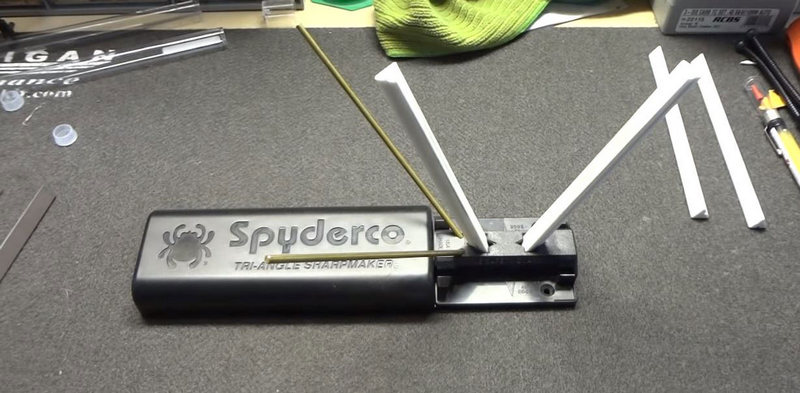
It’s an easy system to learn and master, and it has its upsides! Having dual rods means that the edge burr is always even – you alternate strokes evenly so the burr never builds up on one side like with a Lansky, KME or Edge Pro. It’s portable, it’s not expensive, and there are additional rods available – diamond and cubic boron nitride (CBN) for quick stock removal as well as an ultra-fine stone for a polished edge.
These stones are all fairly pricey though, and can push the Sharpmaker up into the price range of nicer sharpeners. Also, while this is technically a guided sharpener, it’s not a jig, so your sharpening job is only as accurate as your technique. And doing any kind of reprofiling on the stock rods is basically impossible – it works great for resharpening knives that are already profiled correctly. We reviewed the Sharpmaker some time ago in more depth here.
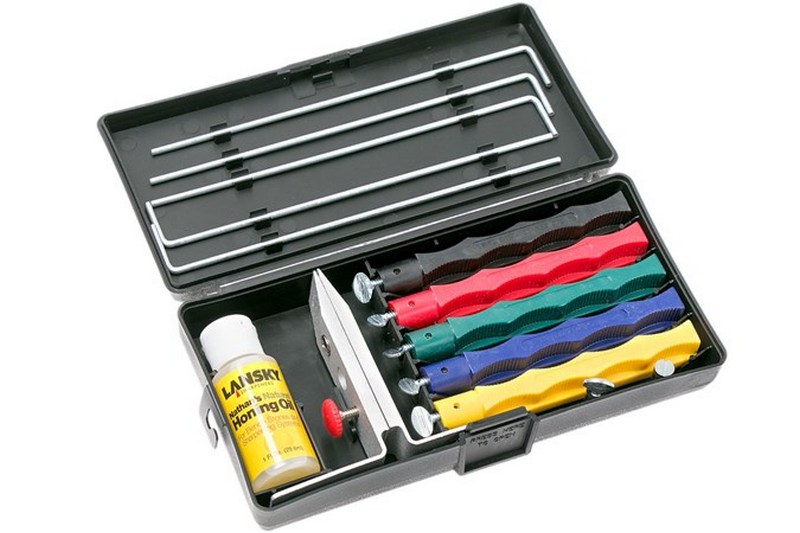
We’ve actually reviewed this kit from Lansky here if you’d like a more detailed breakdown, but the Lansky is an affordable guided rod kit that will get you decent results if you have good technique, but is not without its drawbacks.
It’s cheap – a name brand kit that’s about what a knockoff Edge Pro goes for, and Lansky invented the basic concept of a guided rod jig sharpener. A series of progressively finer grit stones attach to rods which pass through angled slots and create a repeatable angle on the edge bevel of the blade. You can choose from 4 fixed slots – 30, 25, 20 and 17 degrees depending on what you’re sharpening and how you want it to cut.
Focusing on technique can produce really impressive edges on the more normal steels. The deluxe kit comes with 5 stones – 80, 120, 280, 600, and 1000 grit, as well as a bottle of honing oil. There are other kits that include diamond stones and natural Arkansas stones if that’s your thing. There is a huge array of accessories available for the Lansky; indulging in too many can quickly bring the price up beyond making sense.
You do need to be careful with how you set up the clamp to avoid scratching the blade – it has a dual screw setup that’s confusing at first. Take care to avoid setting the clamp too deep on the blade, which can cause the stones to contact the clamp on lower angles. Also, the basic design means it’s not as accurate as nicer setups – the slots the rods go through have more wiggle room than a spherical joint will, but keeping your index finger on top of the rods helps to stabilize them. Anecdotal evidence says to skip the 80 grit stone and go straight to the 120 for re-profiling, and apply the honing oil liberally to the coarse stones – only use a tiny bit on the fine.
The Lanksy is a good value sharpener, or a good “stepping stone” sharpener before you long for something more accurate. It’s a deep rabbit hole.
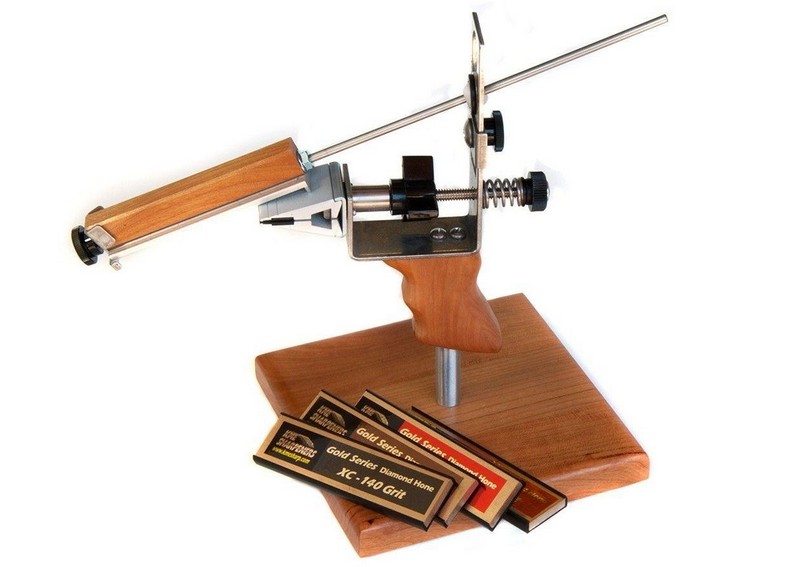
KME is a relatively recent addition to the guided sharpener market, but it’s been gathering a lot of converts lately thanks to some innovations and attractive pricing (depending on your tastes.) For $180 the standard kit includes 4 different grit diamond stones (140, 300, 600, 1500) along with a water bottle and a cleaning cloth. On top of that, the Deluxe kit adds a super coarse 50 grit stone creatively named “The Beast”, an extra extra course 100 grit, three ceramic stones (80/120/320) and a medium/fine Arkansas stone, and some goodies like a honing oil dropper, stone thickness compensator, and the wooden base which is not included with the standard sharpener. In addition, the Deluxe Kit also comes with a kangaroo leather strop and a bottle of 4 micron CBN emulsion to really take your edges to the next level.
The KME functions similarly to the Lansky, only improved in all the small details. Where the Lansky has wide slots for the rods to pass through to set the angle, the KME uses a spherical ball bearing rod guide. The rod passes through the ball and then can pivot smoothly while maintaining an accurate angle with no deviation – giving you a cleaner more precise edge. Also, while a Lansky has four slots for angle – 30, 25, 20, and 17 – the KME is infinitely adjustable between 30 and 17 degrees on a sliding scale, so you can get the precise angle you want. And you can leave the sharpener on the stand and pull outward on the knife handle, and rotate it over 180 degrees to sharpen the other side, rather than flipping the whole sharpener over – making changing sides easier. It’s just a bunch of refinements on a tried and true concept, and it works very well.
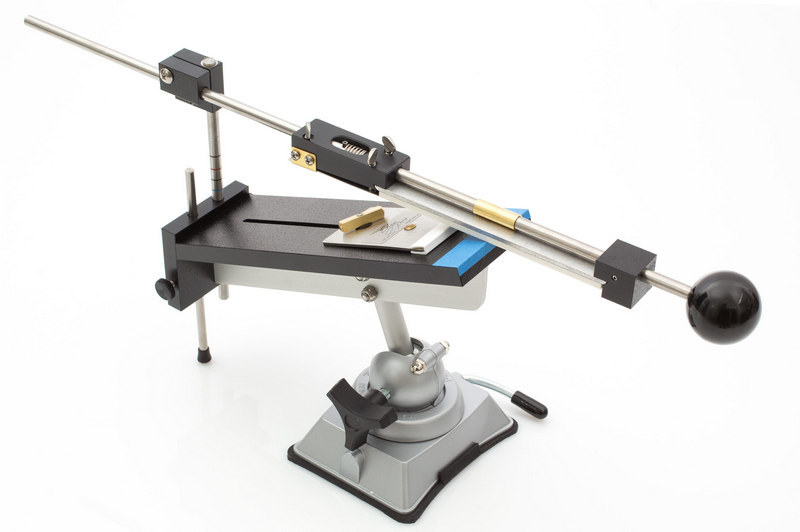
The Edge Pro Apex is, and has been, the default high-end sharpener of the enthusiast knife market for years. It is a guided rod sharpener but it works different in principle than the Lansky or KME-style sharpeners. The base of the sharpener attaches to a table with a pair of suction cups (or an optional bench mount) and the blade rests spine-down on a movable shelf which is adjusted to fit the size of the blade. The guided rod is a two piece setup, where the vertical rod slots into the base and the horizontal rod holds the stone. The colored rings on the vertical rod indicate 3 degree increments starting from 15 degrees, allowing for easy angle setting. With the platform set and the angle selected, you place the knife on the sharpener with the edge facing you and run the stone across the edge, sliding the blade along the shelf to reach the entire edge. For a demonstration of technique, check out this video.
The Apex model is available in 4 different kits, starting with the $165 Apex 1. It’s a bare bones kit that includes 220 and 400 grit water stones, a water bottle and a cloth. The Apex 2 kit adds a 600 grit water stone, a 6” ceramic hone, and DVD instructions for $200. Apex 3 ($225) adds a coarse 120 grit and super fine 1000 grit stones. The Apex 4 at $255 adds 2000 and 3000 grit polishing tapes for mirror finish edges and 2 mounting blanks. There are also accessories like a scissor attachment for added versatility, and a series of diamond matrix bonded stones (from 250 all the way through 4000 grit) which are better suited for modern “super steels.”
I reached out to Edge Pro for some advice and feedback on their system and got a very polite response back (Edge Pro is known for their exemplary customer service in the knife industry, by the way.) Cody made a few salient points on what makes the Edge Pro system better than some competitors. First, the edge of the blade faces you while you’re sharpening, which allows you to see the edge forming. This prevents you from removing more metal than is necessary, which makes the sharpening process extremely efficient and makes your knives last longer. The system also doesn’t use a clamp (like most other sharpeners) which allows you to reach lower sharpening angles, sharpen any length of blade and various blade shapes.
The Apex system is fairly pricey (although not nearly as much as the Professional model, which starts at $475!) but many people agree that it’s the best way to sharpen knives, and the customer service and lifetime warranty help as well.
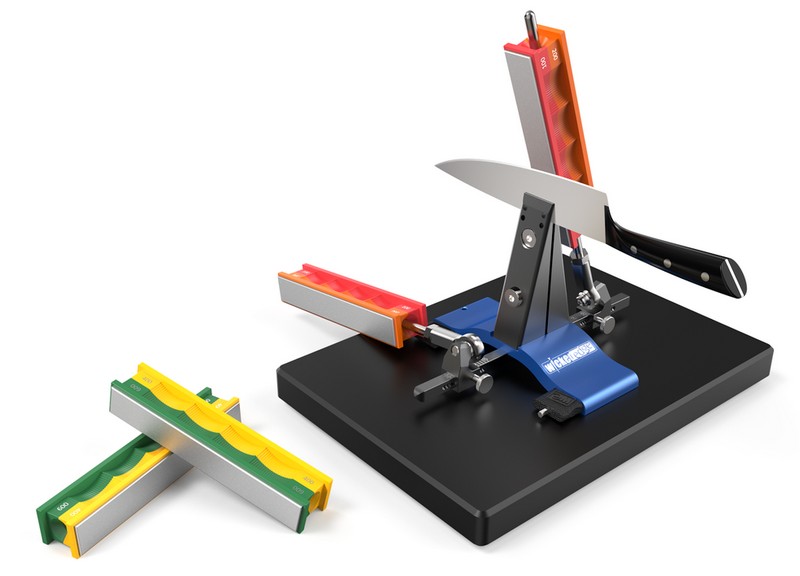
The Wicked Edge is the Cadillac of knife sharpeners. You don’t need a Cadillac to get to work. A Toyota Corolla (let’s say that’s the Lansky) will get you to work. But everyone wants the Cadillac. It’s got a heated steering wheel. Who wants cold hands?
There are of course tons of Cadillac models and the same is true with Wicked Edge, but they’re all Cadillacs. We’re focusing on the original style Wicked Edge here, called the Precision Sharpener. It’s available in three different configurations – WE100, 120, and 130 as well as three “Pro Packs” that all add in additional accessories to raise your game. Make no mistake: these are expensive, with the most basic system starting at $325 – more than the loaded Edge Pro Apex model. But there’s more to it.
The Wicked Edge uses two sets of stones, rather than single one. The knife is positioned vertically with the edge facing up, perpendicular to the sharpener, and the stones slide over a pair of guide rods, one on each side. On the Precision Sharpener the angles are set independently per side, and you alternate strokes with the pair of stones to evenly sharpen the edge. To reduce the number of parts, the stones are two sided with different grits – the lower stone is a 100/200 combo and the higher stone is a 400/600 combo.
I reached out to Wicked Edge for feedback on their system and what puts it a cut above other setups, and got a very detailed response back from Clay. Obviously, the big thing is the use of a clamp and dual stones freeing you to sharpen both sides at the same time – saving time and complication of flipping the blade over. Wicked Edge also avoids dealing with the art of forming a burr and flipping the knife which happens when you’re only working one side of the edge bevel at a time (like the Sharpmaker, actually.) The Wicked Edge also has “robust indexing features that make it very easy for the user to return the knife to the same position for every sharpening session meaning that they don’t have to take extra time setting up the knife each time nor have to remove metal unnecessarily for each touch-up.”
Clay from Wicked Edge also pointed out that Wicked Edge comes standard with diamond/ceramic stones whereas Edge Pro and other systems use traditional water stones which require more maintenance and generally don’t last as long – and life expectancy of the stones is typically double other systems since they’re only used half as much.
Options for the Wicked Edge precision sharpener are vast. All three of the standard models (WE100/120/130) come with two sets of stones – 100/200 and 400/600 – but the 120 includes micro edge angle adjustments (0.05 degree) and wider angle selection – 13-35 versus the standard 15-30. The WE130 adds an improved clamp design, cam driven with free floating jaws that get a better purchase on full flat ground blades or blades with a distal taper, as well as longer 10” guide rods. The Pro Pack versions add more goodies to the standard sharpeners – additional abrasives, bases, that sort of thing. All of the Wicked Edge sharpeners will put a crazy edge on your knives, but they are a bit complicated and expensive.
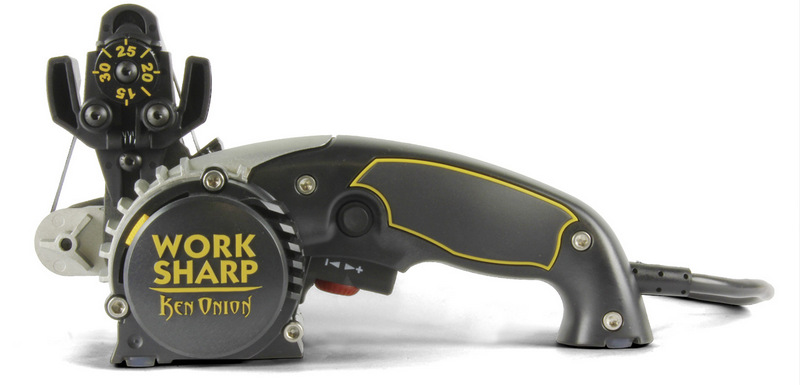
The Ken Onion Edition is a variant of the standard Work Sharp electric power knife sharpener, developed with input by the man himself – surely you’re familiar – to work specifically on knives.
This is the first electric sharpener on our list, and one of only two that I think are worth looking at for real knife enthusiasts. Many electric knife sharpeners are just sort of glorified pull-through sharpeners – they create a lopsided burr that will tear up a steak for a few cuts – but the Work Sharp is more akin to a powered Sharpmaker. It uses a 120V/1.5 Amp electric motor to drive a flexible belt in a triangle shape, and a guide fits over the belt. The angle of the guide is adjustable between 15 and 30 degrees per side (so 30-60 inclusive) and you place the blade in the guide, sharpening one side then flipping to the other, leaving a convex edge bevel (as opposed to most of the rod sharpeners which do flat edge bevels) which Work Sharp and Ken Onion claim is more durable than a flat edge.
The Ken Onion edition Work Sharp comes with 5 different grit belts stock – all flexible style belts with stacked abrasives for longer working life, made by Norton, from extra course to extra fine. There is also a blade grinding attachment available separately that lets you tweak blade profiles and do much more in depth work (such as changing a flat ground blade to a convex ground blade) with some practice.
People familiar with the Work Sharp in practice say that it’s an easy way to get a screaming sharp blade – but, not surprisingly, it’s an easy way to absolutely ruin a blade. Common errors include running the tip of the blade too far down the belt and rounding it off to a blunt point, as well as the Work Sharp’s propensity to scratch unmasked blades with bits of metal as you pull it across the belt. It’s an extremely useful device, but one that warrants fully reading the manual and practicing on some of your cheap/ugly knives first.

Want to go nuts with your sharpener? How about an electric powered wet-stone with a built in leather strop wheel to boot?
Totally different from the other sharpeners on this list, the Tormek T-4 is more a piece of industrial equipment and less a hobbyist sharpener. The T-4 uses an 8” Aluminum Oxide sharpening stone that rotates on a 120w/230V electric motor. The bottom of the stone rests in a water trough that keeps the edge of the stone lubricated while it’s turning, which both cleans the stone and cools the item being sharpened (avoiding overheating it and ruining the tempering.) The standard stone with the Tormek is approximately 220 grit; using the stone grading tool (including) smooths it out to around 1000 grit for fine finishing. Once you’ve got a clean edge grind, use the built in leather strop wheel to straighten out the burr, and you’ve got a scary sharp knife.
Of course, the Tormek is a just a grinder- you’ll need to buy some extras to turn it into a sharpener. The SVM-45 knife jig ($45) is obviously required, and the TT-50 stone truing tool ($93) is also a good idea for maintenance of the abrasive wheel. The WM-200 Anglemaster allows you to both measure and set angles of any tool for accurate adjustment and sharpening. You can also get a Japanese water stone wheel that measures in around 4000 grit for razor-sharp clean edges. There are other wheels available in the larger size used on the Tormek T-8 (which is considerably costlier) including diamond matrix stones and a blackstone silicon wheel that’s extra abrasive, but they don’t fit the smaller T-4 model.
The Tormek systems are pricey, require lots of setup, and like the WorkSharp an inexperience user can ruin the knife – or the system – in a matter of minutes. But they can put absolutely insane edges on anything (the systems are compatible with a wide array of jigs for sharpening anything) in a way most other systems cannot.
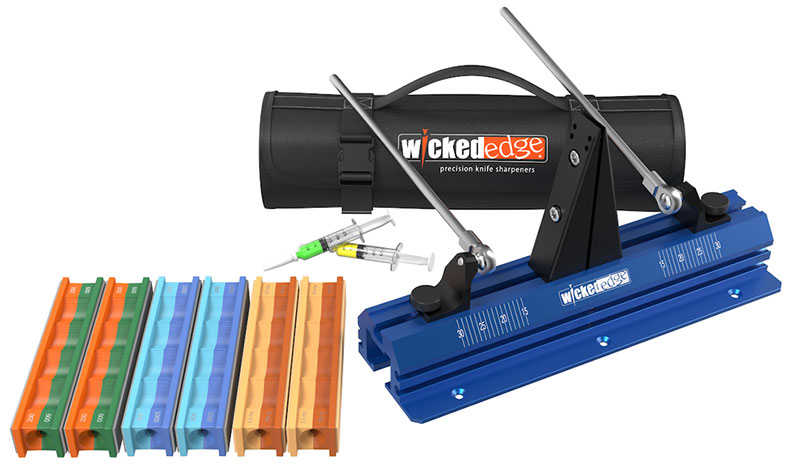
The last item on our list is one of the most recent additions to the high end sharpening market, and it’s an entry-level/portable sharpener from Wicked Edge. Designed to be simpler and more user-friendly than the more complicated Wicked Edge Precision Sharpener mentioned earlier in this list, the Wicked Edge Go is similar in theory. It uses an extruded aluminum base which the standard clamp fits onto perpendicularly. Like the regular Precision Sharpener, the angle of the rods are independently adjustable, and the guide rods thread into heim joints which maintain a steady angle across the surface of the blade.
The stones (200/600 grit included with the kit) slide over the guide rods, and the blade mounts vertically with the edge up – like the other Wicked Edge systems. You pass the stones over the edge one at a time, maintaining an even bevel and steady progress on the edge, before switching over to the finer grit side of the stones. Like the Sharpmaker, the Wicked Edge Go is mostly self-contained: the guide rods and stones fit into slots machined in the body itself. It also includes a c-clamp for mounting the base solidly to a table.
The Wicked Edge Go has some downsides compared to the original – it’s not able to be upgraded, such as with the fine angle adjustment collars or the Gen 3 cam driven vice with independent jaws. It does use the same stones as the original Wicked Edge, so you can buy additional high grit or stropping stones to complete your setup if you like. But as a less insane entry in the market, the more reasonably priced Wicked Edge Go is probably what most knife nuts are going to want on their bench at home. And it won Accessory of the Year at the 2017 Blade Show. Hey, you can use that extra $200 or so dollars to buy more knives. Isn’t that the point?
That wraps up our list of the best sharpeners on the market for knife enthusiasts. Did I miss your favorite sharpener? Get in touch.





